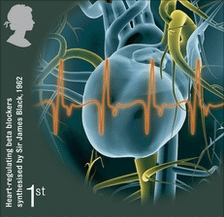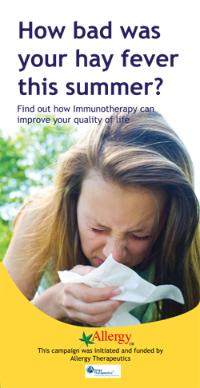Allergy and Immunity - Into the Modern Era
Immunology started as a Tayside clinical service in November 1972 following the appointment of John Swanson Beck as Professor of Pathology. The service was based on his earlier pioneering fluorescent antibody studies on the demonstration and classification of antibodies to the cell nucleus (antinuclear antibody - ANA), which proved to be significant in the diagnosis of connective tissue diseases. This methodology formed the basis for developing an extensive repertoire of autoantibody assays.
Increasing incidence of allergic diseases in recent years, coupled with confusion and lack of political will to address the issues, has put tremendous pressure on the Health Service. There is now a wide gap between need and provision, and patients often resort to dubious allergy practitioners in the field of alternative medicine. All health care providers have a duty to take allergy seriously.
 Image left: Diagram of increasing allergy trends (British Medical Journal)
Image left: Diagram of increasing allergy trends (British Medical Journal)
Within Tayside Immunology Group, the University of Dundee Immunology Department’s current research focuses on various aspects of normal immune function and how aberrations of the immune response contribute to human immunological diseases. Key areas of expertise include leucocyte signalling, immunoglobulin structure and function, clinical immunology and immunogenetics, and immunology of skin disorders.
Dr Susanna Fagerholm’s research group is interested in leukocyte β2-integrins. Integrins are key players in immune responses, as they mediate binding between leukocytes and other cells, and components of the immune system. The group is currently investigating the molecular mechanisms that regulate β2-integrins in leucocytes, and their role in diseases such as systemic lupus erythematosus, where genetic variations can increase the risk of developing the disease.
Led by Professor Brian Lipworth, the Tayside Asthma and Allergy Research Group was set up in 1997 and comprises a team of doctors, scientists, nurses and technicians whose aim is to improve the quality of life for people who suffer from breathing problems like asthma, hayfever and COPD through public awareness, education and research.
 Image right: Stamp featuring Sir James Black’s discovery of beta blockers, issued in 2010
Image right: Stamp featuring Sir James Black’s discovery of beta blockers, issued in 2010
Beta-blocking drugs were famously discovered by the Nobel Prize-winning Sir James Black, later Chancellor of the University. Beta-blockers are contraindicated in asthma because they can induce bronchoconstriction after acute dosing, as shown so vividly (and bravely) by Dr RS McNeill of Maryfield Hospital in Dundee back in 1964. However, Professor Lipworth’s team now think that low dose beta blocker treatment may actually benefit asthma, akin to their use in heart failure.

Image left: Recent Hayfever leaflet (Allergy Therapeutics)
You can find out more about current research in this field by following these links: